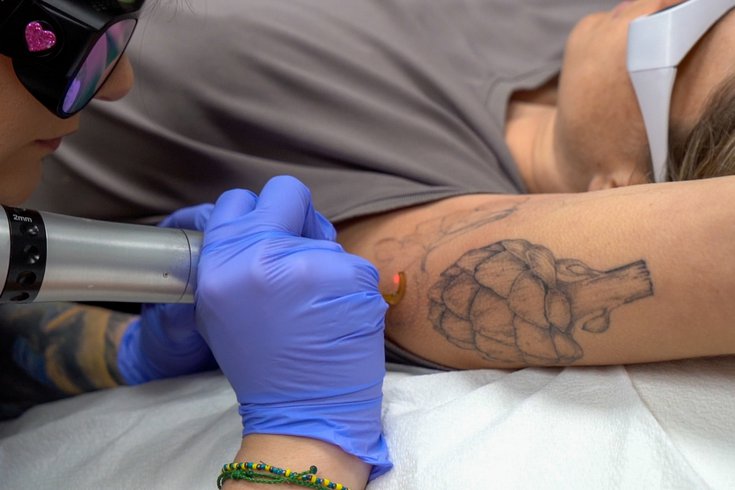
May 23, 2023
 Provided image/Removery
Provided image/Removery
Removery, which just opened its fifth location in the wider Philly area, eliminates tattoos with picosecond lasers.
Over 13 years of lasering off people's tattoos, Carmen VanderHeiden Brodie has seen her share of ill-advised ink. The dolphin lower back tattoos, infinity symbols, Luke Skywalker quotes, even a design someone got on a dare that she hazily remembers as "a skull on a keg stand."
But she also knows that tattoo removal is about much more than blasting a regrettable mustache off your index finger. It's about helping people move on to the next phase of their lives.
"People are changing their outside to reflect who's on the inside now," she said. "If you think about yourself and how much you've changed in the last five years, 10 years, 20 years, it's a lot. All of our clients have put something on the outside that very much represented who they were then and what they believed or what they thought was good, what art was good at that point.
"Things have have evolved and we help them with that evolution."
VanderHeiden Brodie is the vice president of clinical operations at Removery, a tattoo removal studio with 148 locations across the U.S., including five in the wider Philadelphia area. (The newest one, in Cinnaminson, opened Tuesday.) It's just one piece of the larger tattoo removal market, which is expected to grow dramatically over the next four years. Current market research predicts a compound annual growth rate of 19.3% between 2020 and 2027, with a particular emphasis on laser treatment, which is what Removery offers.
Over a series of sessions, specialists at Removery eliminate unwanted tattoos with laser beams, breaking up the ink particles in concentrated bursts. The process usually takes multiple months and at least $1,000 to complete, but for patients seriously seeking tattoo removal, the hurdles are worth it. VanderHeiden Brodie says customers have usually thought about the procedure for three to five years before they book their first consultations.
"The amount of time that somebody thinks about getting removal is generally a very, very long time," she said. "[First] they'll see if they can live with it. Lots of 'em will try to cover it up first and that never works. Then they end up with something double as big and double as dark, and they hate that even worse.
"So once they come into the consultation and have made the time commitment to come in, they're usually pretty ready to go."Quick and easy partial tattoo removal! pic.twitter.com/xhwm2DWdyl
— Removery (@removery_us) February 3, 2022
The people who walk through the company's doors might be there for the reasons you'd expect: a youthful mistake or failed relationship. But messy breakups account for less than a quarter of business, VanderHeiden Brodie says. Someone might seek removal instead for dated artwork or a poor application. In multiple videos on Removery's YouTube channel, patients describe a design that wasn't really the style they wanted, or came out larger than they envisioned. Other customers are so-called "collectors," enthusiasts so covered in ink that they simply need to free up space for their next tattoos.
But patients might also be putting something more serious behind them, like time in prison or horrific abuse.
"People who have formerly been incarcerated, formerly part of sex trafficking, maybe in prison in order to survive, got a tattoo that's not who they are," VanderHeiden Brodie says. "It's not what they would've chosen on the outside, but for survival purposes they put something on and are now reentering society."
For these patients — especially those with what industry pros call "job-stopper tattoos" along the face, hands or neck — Removery may cover the cost of their removal sessions through the INK-initiative program. Applications require a letter of recommendation from an advocate, like a social worker or parole officer, who can attest to the individual's "community-based support to move forward." Qualifying examples of tattoos include not just gang insignia but symbols of hate, like a swastika.
"They're not tattoos, they're scars," a patient named Robin, who was in an abusive relationship with a neo-Nazi for two years, says in one video.
VanderHeiden Brodie says the business has changed a lot since she started. The technology was nanosecond lasers, not picosecond lasers, that were tougher on the skin. She also knows why people still think the procedure leaves scarring — because tattoo removal did, before there were lasers specifically designed for body art.
But now, advancements are making the service more accessible to more people.
"I'm an old grandma in the industry," she laughs. "So it's just really cool to see how the industry has advanced and changed in the amount of time I've been in [it], and how much more we know now than way back in the day when I started."
Follow Kristin & PhillyVoice on Twitter: @kristin_hunt
| @thePhillyVoice
Like us on Facebook: PhillyVoice
Have a news tip? Let us know.